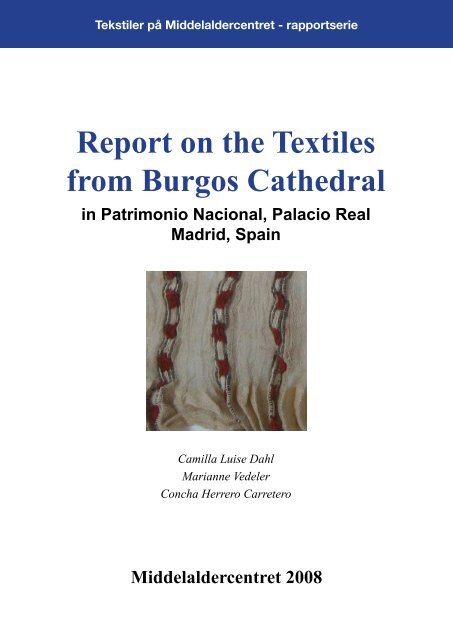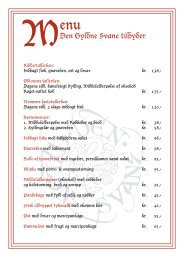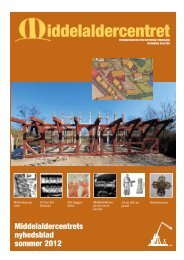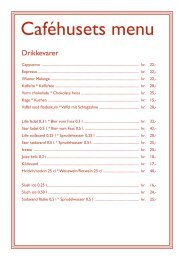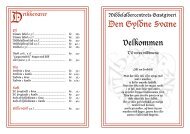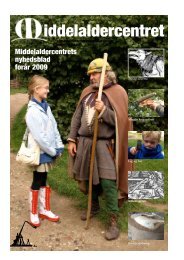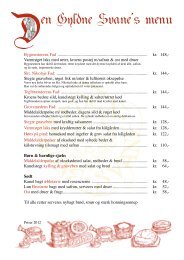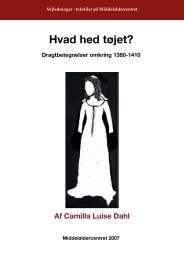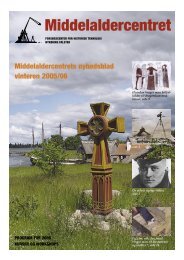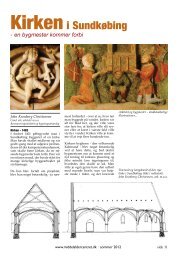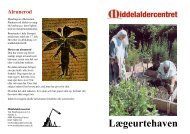Report on the Textiles from Burgos Cathedral - Middelalder Centret
Report on the Textiles from Burgos Cathedral - Middelalder Centret
Report on the Textiles from Burgos Cathedral - Middelalder Centret
You also want an ePaper? Increase the reach of your titles
YUMPU automatically turns print PDFs into web optimized ePapers that Google loves.
Tekstiler på <strong>Middelalder</strong>centret - rapportserie<br />
<str<strong>on</strong>g>Report</str<strong>on</strong>g> <strong>on</strong> <strong>the</strong> <strong>Textiles</strong><br />
<strong>from</strong> <strong>Burgos</strong> Ca<strong>the</strong>dral<br />
in Patrim<strong>on</strong>io Naci<strong>on</strong>al, Palacio Real<br />
Madrid, Spain<br />
Camilla Luise Dahl<br />
Marianne Vedeler<br />
C<strong>on</strong>cha Herrero Carretero<br />
<strong>Middelalder</strong>centret 2008
<strong>Textiles</strong> <strong>from</strong> <strong>Burgos</strong> Ca<strong>the</strong>dral<br />
in Patrim<strong>on</strong>io Naci<strong>on</strong>al, Palacio Real<br />
Madrid, Spain<br />
<strong>Textiles</strong> excavated at <strong>Burgos</strong>, now in <strong>the</strong> Patrim<strong>on</strong>io Naci<strong>on</strong>al, Madrid. Top left, inv. no. 653742, bottom<br />
left, close-up of inv. no. 653745 and right inv. no. 653742 and 651983.<br />
The cloister church in M<strong>on</strong>asterio de Santa María la Real de las Huelgas in <strong>Burgos</strong>, Spain had been<br />
burial site for members of <strong>the</strong> royality and nobility in Spain in <strong>the</strong> Middle Ages. Named Kings and<br />
Queens had been buried here in <strong>the</strong> 12th to <strong>the</strong> 14th century. In 1946 several of <strong>the</strong> coffins in <strong>the</strong><br />
M<strong>on</strong>asterio was examined by Spanish archeaolgist Manuel Gomez-Moreno, <strong>the</strong> excavated textiles which<br />
counted silk covers, blankets, headwear, footwear and dresses were transported to <strong>the</strong> Nati<strong>on</strong>al Museum<br />
in Spain, Patrim<strong>on</strong>io Naci<strong>on</strong>al in Madrid. Unfortunately many items taken <strong>from</strong> <strong>the</strong> coffins has not been<br />
well documented in 1946, except for <strong>the</strong> garments and textiles discovered in <strong>the</strong> royal graves, many<br />
discovered items are of no l<strong>on</strong>ger known c<strong>on</strong>text as it has not been documented which coffins <strong>the</strong>y were<br />
taken <strong>from</strong>.<br />
The textiles has since been re-examined and re-c<strong>on</strong>served, now with documentati<strong>on</strong>, inventory<br />
number and descripti<strong>on</strong> of each piece held at <strong>the</strong> Patrim<strong>on</strong>io Naci<strong>on</strong>al.
In september 2006 a selecti<strong>on</strong> of pieces of<br />
what has been described as head- and neckwear,<br />
excavated in <strong>Burgos</strong>, were examined for textile<br />
analysis and fur<strong>the</strong>r descripti<strong>on</strong> for a project<br />
<strong>on</strong> medieval headwear at <strong>the</strong> Medieval Centre,<br />
Denmark. The examinati<strong>on</strong> was carried out<br />
by dr. art. Marianne Vedeler, Museum of<br />
Cultural History, University of Oslo and mag.<br />
Camilla Luise Dahl, The Medieval Centre,<br />
Nykøbing, Denmark toge<strong>the</strong>r with Dr. C<strong>on</strong>cha<br />
Herrero Carretero, head of <strong>the</strong> Department of<br />
C<strong>on</strong>servati<strong>on</strong>, Patrim<strong>on</strong>io Naci<strong>on</strong>al.<br />
The examinati<strong>on</strong> included 11 silk pieces,<br />
inventory numbers: (00653737), (00653742),<br />
(00653745), (00653753), (00653754),<br />
(00653737), (00651970), (00651981), (00651982),<br />
(00651983), (00651984), (00651985).<br />
In 1995 <strong>the</strong>se textiles were re-c<strong>on</strong>served at<br />
<strong>the</strong> Department for C<strong>on</strong>servati<strong>on</strong> at Patrim<strong>on</strong>io<br />
Naci<strong>on</strong>al by dr. C<strong>on</strong>cha Herrero Carretero.<br />
The textiles are each documented by inventory<br />
number, material, place of origin and possible age.<br />
The textiles were all very well preserved,<br />
<strong>on</strong>ly in places where <strong>the</strong> textiles had been in direct<br />
c<strong>on</strong>tact with <strong>the</strong> decaying flesh of <strong>the</strong> corpses, <strong>the</strong><br />
fine silk had rotten away. Human tissue still in<br />
<strong>the</strong> textiles left brown stains <strong>on</strong> <strong>the</strong> examinati<strong>on</strong><br />
gloves.<br />
For <strong>the</strong> project at The Medieval Centre,<br />
Nykøbing we needed textile analysis of tread<br />
count, tread thickness and weaving which was<br />
carried out by Marianne Vedeler as well as<br />
descripti<strong>on</strong> of <strong>the</strong> methods used for creating <strong>the</strong><br />
unusual frilled edges <strong>on</strong> <strong>the</strong> textiles, which was<br />
examined by Camilla Luise Dahl.<br />
Documentati<strong>on</strong> for Inv. no. 651982
Examinati<strong>on</strong> of <strong>the</strong> <strong>Textiles</strong> <strong>from</strong> <strong>Burgos</strong> in Patrim<strong>on</strong>io<br />
Naci<strong>on</strong>al, Palacio Real, Madrid.
Examinati<strong>on</strong> of <strong>the</strong> <strong>Textiles</strong> <strong>from</strong> <strong>Burgos</strong> in Patrim<strong>on</strong>io<br />
Naci<strong>on</strong>al, Palacio Real, Madrid.
<str<strong>on</strong>g>Report</str<strong>on</strong>g> <strong>on</strong> <strong>the</strong> <strong>Textiles</strong> in Patrim<strong>on</strong>io Naci<strong>on</strong>al,<br />
Palacio Real:<br />
Textile Analysis<br />
From textile studies in Palacio Real, Madrid, 4-6.9.2006<br />
Marianne Vedeler, Museum of Cultural History, University of Oslo<br />
On September 4-6th, 2006, a simple tecniqual<br />
analysis of silk bands with frilled edges was<br />
undertaken by Marianne Vedeler, under supervisi<strong>on</strong><br />
of c<strong>on</strong>servator C<strong>on</strong>cha Herrero Carretero. Camilla<br />
Luise Dahl and myself were shown 11 textiles <strong>from</strong><br />
<strong>the</strong> m<strong>on</strong>astery Santa Maria la Real de Huelgas in<br />
<strong>Burgos</strong>. The bands have most likely been used for<br />
head dressing, and sec<strong>on</strong>darily as part of <strong>the</strong> burial<br />
costume. The bands are primarily made of silk,<br />
some of <strong>the</strong>m with elements of metalwork. Four of<br />
<strong>the</strong> presented textiles where examined in regard to<br />
textile analysis by me: No 653742, No 653737, No<br />
651983 and No 651981.<br />
No 653742<br />
From unidentified grave in <strong>the</strong> m<strong>on</strong>astery Santa<br />
María la Real de Huelgas, <strong>Burgos</strong>.<br />
Material: Silk<br />
1<br />
A band with frilled edges. Length: 267 cm, width:<br />
13 cm. Edges with thicker warp in 1, 5-1, 6 cm<br />
width <strong>from</strong> each selvedge. The textile is pleated in<br />
both sides. A ribb<strong>on</strong> is sewn to <strong>on</strong>e of <strong>the</strong> bands<br />
selvages. The ribb<strong>on</strong> is also pleated, but here <strong>the</strong><br />
pleating is tighter than in <strong>the</strong> primary band. The<br />
ribb<strong>on</strong> is probably pleated separately form <strong>the</strong> main<br />
band.<br />
There are five stripes in red, brown and white in <strong>on</strong>e<br />
end of <strong>the</strong> band.<br />
Fig. 1<br />
Central part of <strong>the</strong> band:<br />
Golden silk made in tabby, z/z-spun, with 36-38/24-<br />
26 threads pr cm in warp and weft. The thickness of<br />
<strong>the</strong> threads are approximately 0, 1-0, 2 mm in both<br />
thread systems.<br />
Fig. 2<br />
Fig. 1<br />
No 653742. A band with<br />
frilled edges. Length: 267<br />
cm, width: 13 cm. Edges<br />
with thicker warp in 1,<br />
5-1, 6 cm width <strong>from</strong> each<br />
selvedge.<br />
Photograph: Marianne<br />
Vedeler.
Edges and selvages:<br />
Golden silk made in tabby, z/z-spun, with 35/24-26<br />
threads pr cm in warp and weft. The thickness of <strong>the</strong><br />
threads of <strong>the</strong> warp is approximately 0, 3 mm, and<br />
a lot thicker than in <strong>the</strong> central part of <strong>the</strong> band. The<br />
area with thicker warp threads is approximately 1,<br />
6-1, 8 cm in with in both sides of <strong>the</strong> band, starting<br />
at <strong>the</strong> simple selvages. The weft threads in this area<br />
are <strong>the</strong> same as in <strong>the</strong> central part, 0, 1-0, 2 mm<br />
thick.<br />
These edges are pleated, but <strong>the</strong>re are no traces<br />
of needle holes or threads used for ruffles. The<br />
upper end of each fold is relatively sharp, and<br />
approximately 0, 4 cm deep <strong>from</strong> bottom to top.<br />
Fig. 3<br />
Ribb<strong>on</strong>:<br />
A golden silk ribb<strong>on</strong> is sewn to <strong>the</strong> band al<strong>on</strong>g<br />
2<br />
Fig. 2<br />
No 653742<br />
Photograph: Marianne<br />
Vedeler.<br />
Fig. 3<br />
No 653742. Edge<br />
with thicker warp<br />
1, 5-1, 6 cm wide.<br />
Photograph: Marianne<br />
Vedeler.<br />
<strong>on</strong>e of <strong>the</strong> selvages of <strong>the</strong> band, making a sec<strong>on</strong>d<br />
frilled edge. Only a few stitches are preserved. The<br />
ribb<strong>on</strong> is 1, 5-1, 6 cm. wide and made in tabby. It<br />
has a simple selvedge in each side, and is made with<br />
double warp threads and single threads in <strong>the</strong> weft.<br />
There are 19/19-20 threads pr cm in warp and weft.<br />
The thickness of <strong>the</strong> threads is 0, 2-0, 3 mm in both<br />
warp and weft, but with double threads in <strong>the</strong> warp.<br />
The ribb<strong>on</strong> is pleated with 0, 5 cm deep folds. The<br />
folds in <strong>the</strong> ribb<strong>on</strong> are set about twice as tight as in<br />
<strong>the</strong> main band. There are no traces of needle holes<br />
or threads used for ruffles.<br />
Fig. 4<br />
Stripes used for decorati<strong>on</strong>:<br />
I <strong>on</strong>e end of <strong>the</strong> band, <strong>the</strong>re are 5 decorative stripes<br />
made of weft threads and embroidered threads in<br />
c<strong>on</strong>trasting colors. The stripes are made in two
groups, with three stripes and two stripes in each<br />
group. The group with two stripes is located in <strong>the</strong><br />
far end of <strong>the</strong> band, and this end is fragmented.<br />
There is a clear possibility that this group originally<br />
c<strong>on</strong>sisted of three stripes.<br />
All stripes are made in <strong>the</strong> same colors, white,<br />
brown and red.<br />
C<strong>on</strong>structi<strong>on</strong> of stripe 1:<br />
1 brown weft thread, 1 white weft thread, 1 brown<br />
weft thread, 4 white weft threads. Al<strong>on</strong>g this white<br />
central part of <strong>the</strong> stripe, 4 threads in red color<br />
are sewn in with simple running stitches. The red<br />
threads form rectangles in <strong>the</strong> centre of <strong>the</strong> stripe.<br />
These rectangles are 0, 5-0, 6 cm l<strong>on</strong>g and 0, 4-0,<br />
5 cm wide. In <strong>the</strong> o<strong>the</strong>r end of <strong>the</strong> stripe, <strong>the</strong>re is 1<br />
brown weft thread, 1 white weft thread and 1 brown<br />
weft thread. All <strong>the</strong> o<strong>the</strong>r stripes are made in <strong>the</strong><br />
same way.<br />
Between <strong>the</strong> tree inner stripes <strong>the</strong>re is a distance<br />
of approximately 1, 8 cm. At <strong>the</strong> end of <strong>the</strong>se tree<br />
stripes <strong>the</strong>re is a 3, 5 cm wide break before <strong>the</strong> last<br />
two stripes separated by 2, 2 cm. The thickness of<br />
3<br />
threads in <strong>the</strong> stripes is:<br />
Red: 0, 9-1 mm<br />
Brown: 0, 6-0, 7 cm<br />
White: 0, 2-0, 3 mm<br />
Fig. 5<br />
Fig. 4<br />
No 653742. Selvedge<br />
and additi<strong>on</strong>al band<br />
each 1, 5-1, 6 cm<br />
wide.<br />
Photograph: Marianne<br />
Vedeler<br />
Fig. 5<br />
No 653742. Decorative<br />
coloured stripes:<br />
width: 0,4-0,5 cm.<br />
Photograph: Marianne<br />
Vedeler<br />
No 653737<br />
From unidentified grave in <strong>the</strong> m<strong>on</strong>astery Santa<br />
María la Real de Huelgas, <strong>Burgos</strong>.<br />
Material: Silk. There is a possibility that o<strong>the</strong>r<br />
materials could have been used in <strong>the</strong> decorati<strong>on</strong>.<br />
A fragmented band in golden silk, with stripes<br />
in c<strong>on</strong>trasting colors. The largest fragment is<br />
approximately 90 cm l<strong>on</strong>g and 15 cm. wide. The<br />
fragment is decorated with 7 groups of stripes, each<br />
group c<strong>on</strong>sisting of 3 stripes.<br />
In <strong>the</strong> centre (between each group of stripes), <strong>the</strong>re<br />
is a 9, 5 cm wide field in tabby silk of gauze-quality.<br />
On both sides of this field, thicker warp threads are<br />
used in a 1, 7 cm wide area, reaching <strong>the</strong> selvages<br />
<strong>on</strong> both sides. Both l<strong>on</strong>g sides are pleated.<br />
A ribb<strong>on</strong>, 1, 3-1, 4 cm wide, is sewn to <strong>the</strong> silk band
Fig. 6<br />
No 653737. The largest fragment is approximately 90 cm l<strong>on</strong>g and 15 cm. wide. The fragment is decorated with 7<br />
groups of stripes, each group c<strong>on</strong>sisting of 3 stripes. Foto: Marianne Vedeler.<br />
4<br />
Fig. 7<br />
No 653737. Selvedges<br />
made with thicker<br />
warp threads: width:<br />
1, 7 cm. The central<br />
piece is of fine silk<br />
gauze. Foto: Marianne<br />
Vedeler.
Fig. 8<br />
No 653737. An additi<strong>on</strong>al ribb<strong>on</strong>, 1, 3-1, 4 cm wide, is sewn to <strong>the</strong> silk band al<strong>on</strong>g <strong>the</strong> selvedges. Foto: Marianne<br />
Vedeler.<br />
al<strong>on</strong>g both selvedges. Ribb<strong>on</strong> and seams are well<br />
preserved. The ribb<strong>on</strong> is also pleated, but <strong>the</strong> folds<br />
are set twice as narrow as in <strong>the</strong> main band. As in<br />
653742, <strong>the</strong> ribb<strong>on</strong> has probably been pleated in a<br />
process separated <strong>from</strong> <strong>the</strong> pleating process <strong>on</strong> <strong>the</strong><br />
main band.<br />
Fig. 6<br />
Central part:<br />
Golden silk made in tabby, z/z-spun, with 39/36<br />
threads pr. Cm in warp and weft. The thickness of <strong>the</strong><br />
threads is c. 0, 1-0, 2 mm in both thread systems.<br />
Fig. 7<br />
Edges:<br />
Golden silk made in tabby, z/z-spun, with 35/26<br />
threads pr.cm in warp and weft. The thickness of<br />
<strong>the</strong> threads in <strong>the</strong> warp is approximately 0, 5 mm<br />
in this area, and <strong>the</strong>reby much thicker than in <strong>the</strong><br />
central part of <strong>the</strong> band. The weft threads are of <strong>the</strong><br />
same type as in <strong>the</strong> central parts. These are pleated<br />
with sharp folds approximately 0, 4- 0, 5 cm deep<br />
<strong>from</strong> bottom to top.<br />
5<br />
Fig. 8<br />
Ribb<strong>on</strong>:<br />
Al<strong>on</strong>g each side of <strong>the</strong> main band, <strong>the</strong>re is a ribb<strong>on</strong><br />
sewn to <strong>the</strong> main textile with simple running<br />
stitches. A z-spun thread in golden silk has been<br />
used to fix <strong>the</strong> ribb<strong>on</strong> to <strong>the</strong> main band. The ribb<strong>on</strong> is<br />
approximately 1, 3 cm wide in <strong>on</strong>e side and 1, 5<br />
cm wide in <strong>the</strong> o<strong>the</strong>r side of <strong>the</strong> band. A silk thread<br />
is running through <strong>the</strong> ribb<strong>on</strong>, holding <strong>the</strong> pleated<br />
folds toge<strong>the</strong>r.<br />
The ribb<strong>on</strong> is made with double warp threads and<br />
single threads in <strong>the</strong> weft. All threads are z-spun.<br />
There are 27 double warp threads and 19 single weft<br />
threads pr. cm.<br />
The thickness of each thread is ca 0, 3 mm in both<br />
warp and weft.<br />
Fig. 9<br />
Decorative stripes:<br />
Stripes made of weft threads and embroidered threads<br />
in c<strong>on</strong>trasting colors are used for decorati<strong>on</strong>. The<br />
largest fragment is decorated with 7 groups of such
stripes, each group c<strong>on</strong>sisting of 3 stripes in blue,<br />
white, red and yellow, in various combinati<strong>on</strong>s.<br />
Pattern of three stripes:<br />
Stripe 1: 1 shuttling with two blue threads, 1 yellow<br />
weft thread, <strong>the</strong>n 4 white weft threads. In this white<br />
centre of <strong>the</strong> stripe, <strong>the</strong>re are sewn 4 red threads by<br />
using simple running stitches. The red threads are<br />
forming rectangles <strong>on</strong> <strong>the</strong> white background, 0, 5-<br />
0, 6 cm l<strong>on</strong>g and 0, 4- 0, 5 cm wide. Then follows 1<br />
shuttling with 2 blue threads, 1 yellow weft thread<br />
and at <strong>the</strong> end 1 shuttling with double blue weft<br />
thread.<br />
There is a distance of 2 cm between this stripe and<br />
<strong>the</strong> next.<br />
Stripe 2: 1 red weft thread, 2 white weft threads,<br />
1 shuttling with <strong>on</strong>e red and <strong>on</strong>e yellow thread,<br />
6<br />
Fig. 9<br />
No 653737. Additi<strong>on</strong>al<br />
ribb<strong>on</strong>, 1, 3-1,<br />
4 cm wide. Foto:<br />
Marianne Vedeler.<br />
Fig. 10<br />
No 653737. Foto:<br />
Marianne Vedeler.<br />
and <strong>the</strong>n 2 yellow weft threads. Into this yellow<br />
centre of <strong>the</strong> stripe, <strong>the</strong>re are sewn 4 blue threads<br />
by using simple running stitches. The blue threads<br />
are forming rectangles <strong>on</strong> <strong>the</strong> yellow background,<br />
0, 5 cm l<strong>on</strong>g and 0, 4 cm wide. Then <strong>the</strong>re is 2 red<br />
weft threads, 2 white weft threads and at <strong>the</strong> end of<br />
<strong>the</strong> stripe 1 red weft thread. Then <strong>the</strong>re is a break of<br />
approximately 2 cm.<br />
Stripe 3: 1 shuttling with two blue threads, 1 yellow<br />
weft thread, 1 shuttling with two blue and <strong>on</strong>e<br />
white thread toge<strong>the</strong>r. Then 3 white weft threads.<br />
In <strong>the</strong> white centre of <strong>the</strong> stripe, <strong>the</strong>re are sewn 4<br />
red threads by using simple running stitches. The<br />
red threads are forming rectangles <strong>on</strong> <strong>the</strong> white<br />
background, 0, 5 cm l<strong>on</strong>g and 0, 4- 0, 5 cm wide.<br />
Then <strong>the</strong>re is 1 shuttling with two blue threads, 1
yellow weft thread and 1 shuttling with two blue<br />
threads. Then <strong>the</strong>re is a 5 cm wide break before <strong>the</strong><br />
next pattern of stripes. This pattern c<strong>on</strong>sists of 3<br />
stripes with a different combinati<strong>on</strong> of colors. The<br />
first stripe is yellow/blue in <strong>the</strong> centre, <strong>the</strong>n <strong>the</strong>re is<br />
a red/white centered stripe, and at <strong>the</strong> end <strong>the</strong>re is a<br />
Yellow/blue stripe again. The third set of stripes has<br />
<strong>the</strong> same combinati<strong>on</strong> of colors as <strong>the</strong> first.<br />
Fig. 10<br />
No 651983<br />
From unidentified grave in <strong>the</strong> m<strong>on</strong>astery Santa<br />
María la Real de Huelgas, <strong>Burgos</strong>.<br />
Material: silk.<br />
Band with frilled edges. Length: 147 cm, with: 18<br />
cm. The bands color is today dull brownish yellow.<br />
There is a l<strong>on</strong>gitudinal crease in <strong>the</strong> middle. The<br />
band is in gauze-quality, with edges made with<br />
thicker warp threads ca 0, 8-1 cm. in width <strong>from</strong><br />
each selvedge. The edges are pleated. There is no<br />
ribb<strong>on</strong> sewn al<strong>on</strong>g <strong>the</strong> selvages of this band, and it<br />
is not decorated.<br />
Fig. 11<br />
7<br />
Fig. 11<br />
No 651983.<br />
Band with<br />
frilled edges.<br />
Length: 147<br />
cm, with: 18<br />
cm. Foto: Marianne<br />
Vedeler.<br />
Central part of <strong>the</strong> band:<br />
Silk woven in tabby, z/z-spun, with 29-32/34 threads<br />
pr cm in warp and weft. The thickness of <strong>the</strong> threads<br />
is 0, 1-0, and 2 mm in both weaving directi<strong>on</strong>s.<br />
Fig. 12<br />
Edges: Silk woven in tabby, with double warp<br />
threads and single weft threads. There are 24 double<br />
warp threads and 34 single weft threads pr. cm. The<br />
thickness of <strong>the</strong> threads is 0, 1-0, 2 mm in both<br />
weaving directi<strong>on</strong>s. The edges are pleated with sharp<br />
fold, 0, 4 cm deep <strong>from</strong> bottom to top. There are<br />
needle holes in <strong>the</strong> top of each fold, approximately<br />
0, 4 cm <strong>from</strong> <strong>the</strong> selvedge. The distance between<br />
<strong>the</strong> holes is 0, 5-0, 6 cm.<br />
Fig. 13<br />
No 651981<br />
From unidentified grave in <strong>the</strong> m<strong>on</strong>astery Santa<br />
María la Real de Huelgas, <strong>Burgos</strong>.<br />
Material: silk.<br />
Simple golden silk band with a red stripe al<strong>on</strong>g <strong>on</strong>e<br />
selvedge. Made in z/z-spun tabby. Length: c. 140<br />
cm, width: c. 11 cm. There is a l<strong>on</strong>gitudinal fold
Fig. 12<br />
No 651983. Foto: Marianne Vedeler.<br />
8<br />
Fig. 13<br />
No 651983. Edges<br />
made with thicker<br />
warp threads c.<br />
0, 8-1 cm. in width.<br />
There are needle<br />
holes in <strong>the</strong> top of<br />
each fold, approximately<br />
0, 4 cm<br />
<strong>from</strong> <strong>the</strong> selvedge.<br />
The distance between<br />
<strong>the</strong> holes is<br />
0, 5-0, 6 cm. Foto:<br />
Marianne Vedeler.
in <strong>the</strong> middle. The band is in gauze-quality, with<br />
double warp threads al<strong>on</strong>g <strong>on</strong>e selvedge.<br />
Fig. 14<br />
Central part:<br />
Silk woven in tabby, hard z/z-spun, 30/29-30<br />
threads pr cm in warp and weft. The thickness of <strong>the</strong><br />
threads is approximately 0, 1 mm in both weaving<br />
directi<strong>on</strong>s.<br />
Fig. 15<br />
Edges:<br />
In <strong>on</strong>e selvedge, <strong>the</strong>re is a streng<strong>the</strong>ning made of<br />
3 thicker z/z-spun warp threads. The thickness of<br />
<strong>the</strong>se threads is approximately 0, 5 mm. al<strong>on</strong>g <strong>the</strong><br />
o<strong>the</strong>r edge, <strong>the</strong>re is a stripe made of red, double<br />
warp threads 0, 6 cm in <strong>from</strong> <strong>the</strong> selvedge. The red<br />
edge is frilled.<br />
Fig. 16-17<br />
Fig. 14<br />
No 651981. Length: c. 140 cm, width: c. 11 cm. Foto: Marianne Vedeler.<br />
9
Fig. 15<br />
No 651981. Foto: Marianne Vedeler.<br />
10
11<br />
Fig. 16 & 17<br />
No 651981. Foto:<br />
Marianne Vedeler.
<str<strong>on</strong>g>Report</str<strong>on</strong>g> <strong>on</strong> <strong>the</strong> <strong>Textiles</strong> in Patrim<strong>on</strong>io Nati<strong>on</strong>al,<br />
Palacio Real<br />
Notes <strong>on</strong> <strong>the</strong> Visual Appearance of <strong>the</strong> Frilled <strong>Textiles</strong> <strong>from</strong> <strong>Burgos</strong><br />
and <strong>the</strong> Methods of C<strong>on</strong>structing Frilled Edges.<br />
From textile studies in Palacio Real, Madrid, 4-6.9.2006<br />
Camilla Luise Dahl, The Medieval Centre, Nykøbing<br />
The collecti<strong>on</strong> of clo<strong>the</strong>s and textiles excavated<br />
<strong>from</strong> <strong>Burgos</strong> Ca<strong>the</strong>dral, now in Patrim<strong>on</strong>io<br />
Naci<strong>on</strong>al: Palacio Real in Madrid, includes a group<br />
of fragmented strips of silk cloth excavated <strong>from</strong><br />
<strong>Burgos</strong> Ca<strong>the</strong>dral. 1 The fragments varies in size<br />
<strong>from</strong> just a quarter of a meter to up to six metres in<br />
length.<br />
Only a few of <strong>the</strong> fragments share obvious<br />
similarities in visual appearance and most of <strong>the</strong>m<br />
creates <strong>the</strong> overall percepti<strong>on</strong> of a variety of styles in<br />
appearance and technique. The l<strong>on</strong>g pieces have all<br />
formed part of women’s headwear. All of <strong>the</strong>m are<br />
made of varying lengths of narrow strips of fabric<br />
and <strong>the</strong>y were used to wrap around chin, neck and<br />
head. Due to <strong>the</strong> lack of method when <strong>the</strong> textiles<br />
were excavated in <strong>the</strong> mid-20th century, <strong>on</strong>ly a<br />
few of <strong>the</strong> pieces can now be linked to a specific<br />
grave. N<strong>on</strong> of <strong>the</strong> extant samples in <strong>the</strong> collecti<strong>on</strong><br />
have intact endings, <strong>the</strong> actual length of <strong>the</strong> pieces<br />
is <strong>the</strong>refore unknown.<br />
Some of <strong>the</strong> pieces are plain whites, o<strong>the</strong>rs have<br />
colourful stripes woven into <strong>the</strong>m at <strong>the</strong> endings<br />
varying <strong>from</strong> many rows of multicoloured stripes to<br />
just a few stripes of a single colour. The width of <strong>the</strong><br />
pieces various <strong>from</strong> 10 to 15 cm, some wider than<br />
20 cm has been folded al<strong>on</strong>g <strong>the</strong> length of <strong>the</strong> fabric<br />
1 Manuel Gomez-Moreno: El Panteón Real de<br />
las Huelgas de <strong>Burgos</strong>. Madrid, 1946, C<strong>on</strong>cha Herrero<br />
Carretero: Museo de Telas Medievales. M<strong>on</strong>asterio de<br />
Santa María la Real de Huelgas. Madrid, 1988, C<strong>on</strong>cha<br />
Herrero Carretero: El Museo de Telas Medievales de<br />
Santa María la Real de Huelgas. Colecci<strong>on</strong>es textiles de<br />
Patrim<strong>on</strong>io Naci<strong>on</strong>al. In: Vestduras Ricas, Madrid, 2005.<br />
In september 2006 <strong>the</strong> textiles were examined by C<strong>on</strong>cha<br />
Herrero Carretero, Patrim<strong>on</strong>io Nati<strong>on</strong>al, Marianne Vedeler,<br />
Oldsakssamlingen, Oslo and Camilla Luise Dahl, The<br />
Medieval Centre for The Medieval Centre, Nykøbing,<br />
Denmark.<br />
12<br />
Fig. 1<br />
Inv. No 00653742 in full length. Photograph: Marianne<br />
Vedeler.
Fig. 2<br />
Inv. No 00653742 and<br />
00651983. Photograph:<br />
C<strong>on</strong>cha Herrero Carretero.<br />
to make a double band of half that width. N<strong>on</strong>e of<br />
<strong>the</strong> fragments can be characterized as veils but are<br />
instead various types of head- and chinbands.<br />
All of <strong>the</strong> examined pieces are made of silk but in<br />
different quality, thickness of thread, density and<br />
tightness. All pieces have various types of ruffled<br />
and pleated edges.<br />
Fig. 1-2<br />
The pieces may overall be grouped as four different<br />
types according to shape and style of <strong>the</strong> frilled<br />
edges:<br />
Type 1: L<strong>on</strong>g narrow pleats al<strong>on</strong>g <strong>the</strong> selvedges<br />
This type is characterized by rows of l<strong>on</strong>g, narrow<br />
pleats formed as part of <strong>the</strong> fabric. The pleats are<br />
neatly made an very even in appearance. Most have<br />
sharp, folded pleats c. 4-5mm deep. The width of<br />
<strong>the</strong> selvedges with this type of pleats is c. 1,5 to 2<br />
cm with a midsecti<strong>on</strong> of about 10-12 cm.<br />
Type 2: Overall pleated surface of fabric<br />
This type of textiles has <strong>the</strong> overall appearance of<br />
13<br />
having been pleated in small, sharps pleats (knife<br />
pleats) <strong>on</strong> <strong>the</strong> entire width of <strong>the</strong> fabric and not just<br />
al<strong>on</strong>g <strong>the</strong> selvedges.<br />
Type 3: Sharp pleats <strong>on</strong> additi<strong>on</strong>al bands<br />
This type has additi<strong>on</strong>al pleated bands sewn to <strong>the</strong><br />
edge of <strong>the</strong> fabric. These bands are thicker and<br />
more coarse than <strong>the</strong> fabrics <strong>the</strong>y aresewn to. The<br />
aditi<strong>on</strong>al bands are c. 2 cm in width.<br />
The bands are folded in sharp, crisp pleats forming<br />
a zigzag-shaped appearance.<br />
Group 4: Small ruffles<br />
This type has small, rounded ruffles al<strong>on</strong>g <strong>the</strong><br />
selvedges formed as part of <strong>the</strong> fabric. In this group<br />
<strong>the</strong> ruffles are tiny and appears as a narrow edge of<br />
frills. The width of <strong>the</strong> ruffles edges are no more<br />
than 5-7mm with a midsecti<strong>on</strong> of c. 10-12cm.<br />
Some of <strong>the</strong> fragments of this type have<br />
characteristics of more than <strong>on</strong>e type, for instance<br />
two of <strong>the</strong> fragments had features of both Type 1<br />
and 3. In some cases it was difficult to determine if<br />
some of <strong>the</strong> pieces of Type 1 were actually Type 2 as
Fig. 3a-b<br />
Inv. no. 00653745 and Inv.no. 00653753: Photograph:<br />
C<strong>on</strong>cha Herrero Carretero.<br />
14
Type 1 Type 2 Type 3 Type 4<br />
(00653745) X (X?) - -<br />
(00653753) - - - -<br />
(00653742) X (X?) X -<br />
(00653737) X X X -<br />
(00651983) X - - -<br />
(00651985) - - - X<br />
(00651982) X - - -<br />
(00651981) - - - X<br />
(00653754) X X - -<br />
(00651970) X X X -<br />
(00651984) X X - -<br />
Table 1<br />
The examined pieces grouped according to type.<br />
some pieces could have traces of<br />
having been entirely pleated and<br />
not just at <strong>the</strong> edges, although now<br />
in a shape that made it impossible<br />
to see clearly.<br />
Two fragments were small<br />
pieces with coloured stripes and<br />
very fragmented silks, <strong>on</strong> <strong>on</strong>e<br />
fragment (00653745) <strong>the</strong> frills<br />
were too fragmented to determine<br />
typewise (possibly Type 1 & 2)<br />
<strong>on</strong> <strong>the</strong> o<strong>the</strong>r <strong>the</strong> frills were not<br />
visible (00653753).<br />
Fig. 3<br />
One piece, a headband discovered<br />
<strong>from</strong> <strong>the</strong> tomb of Queen Elenor,<br />
was under c<strong>on</strong>servati<strong>on</strong> and could not be examined<br />
during <strong>the</strong> visite. In all 11 numbers were available<br />
for examinati<strong>on</strong>. Ano<strong>the</strong>r 20 numbers of similar<br />
textiles are in <strong>the</strong> collecti<strong>on</strong> in Patrim<strong>on</strong>io Real but<br />
was not examined <strong>on</strong> this visite.<br />
Examples of Type 1<br />
Examples of Type 1 are <strong>the</strong> numbers 00653745,<br />
00653742, 00653737, 00651983, 00651984<br />
00651982, 00653754 and are by far <strong>the</strong> most wellrepresented<br />
type am<strong>on</strong>g <strong>the</strong> textiles. (Table I)<br />
The numbers 00653745, 00653742, 00653737<br />
and 00653754 are combined with features <strong>from</strong><br />
15<br />
Fig. 4<br />
Inv. No. 00653742. Photograph: C<strong>on</strong>cha Herrero<br />
Carretero.
<strong>on</strong>e or two of <strong>the</strong> o<strong>the</strong>r types. For no 00653745<br />
and 00653742 <strong>the</strong> combinati<strong>on</strong> with Type 2 is<br />
uncertain.<br />
The numbers 00653742 and 00653737 are<br />
combined with both Type 2 and 3. <strong>the</strong>se two textiles<br />
are very similar in style, quality and weave, yet no<br />
00653737 has more decorate stripes.<br />
The numbers 00651982 and 00651983 are not<br />
combined with any o<strong>the</strong>r types. The two pieces are<br />
very similar, both with small pierced holes through<br />
16<br />
Fig. 5<br />
Inv. No 00651982.<br />
P h o t o g r a p h :<br />
C<strong>on</strong>cha Herrero<br />
Carretero.<br />
Fig. 6<br />
Inv. no. 00651984.<br />
P h o t o g r a p h :<br />
Marianne Vedeler.<br />
<strong>the</strong> pleats at <strong>the</strong> edges. One fragment has three blue<br />
stripes, <strong>the</strong> o<strong>the</strong>r is plain without decorati<strong>on</strong>. Both<br />
<strong>the</strong>se numbers have less difference between <strong>the</strong><br />
pleated edges and <strong>the</strong> midsecti<strong>on</strong> than any of <strong>the</strong><br />
o<strong>the</strong>r pieces.<br />
Fig. 4 , 5, 6.
Examples of Type 2<br />
Examples of Type 2 are <strong>the</strong> numbers (00653737),<br />
(00653754), (00651970) and (00651984).possibly<br />
<strong>the</strong> numbers (00653745) and (00653742) have<br />
had a similar structure. possibly this structure is<br />
achievedby various means, in some pieces <strong>the</strong> overall<br />
Fig. 7c-d<br />
Fragment of Inv.. no. 00653737. Photograph: C<strong>on</strong>cha<br />
Herrero Carretero.<br />
17<br />
Fig. 7a-b<br />
Inv. no. 00653754. Photograph: Marianne Vedeler
Fig. 10<br />
Inv. No 00653737. Photograph: Marianne Vedeler.<br />
18<br />
Fig. 8<br />
Inv. No. 00651984.<br />
Photograph: Marianne<br />
Vedeler.<br />
Fig. 9<br />
00653742. Photograph:<br />
C<strong>on</strong>cha Herrero<br />
Carretero.
Fig. 11a-b<br />
Inv. No 00653737. Photograph: Marianne Vedeler &<br />
C<strong>on</strong>cha Herrero Carretero.<br />
pleated surface is clearly due to an aftertreatment –<br />
<strong>the</strong> fabric being neatly folded into sharp, tiny pleats.<br />
In o<strong>the</strong>rs <strong>the</strong> result may have been achieved by <strong>the</strong><br />
spinning of <strong>the</strong> thread, in this case with a high twist<br />
in <strong>the</strong> yarn resulting in a crepe-like surface. This<br />
feature must have been combined with pleating <strong>the</strong><br />
fabric afterwards. Some of <strong>the</strong> fragments are very<br />
creased and wrinkled and it is difficult to determine<br />
which fragments have had a pleated surface and<br />
which are just creased due to <strong>the</strong> tightness of <strong>the</strong><br />
spinning of <strong>the</strong> yarn (crepe-effect).<br />
Fig. 7, 8, 9.<br />
Examples of Type 3<br />
Three of <strong>the</strong> numbers in <strong>the</strong> examined group had<br />
19<br />
additi<strong>on</strong>al pleated bands sewn to <strong>the</strong> edge, <strong>the</strong>se<br />
are <strong>the</strong> numbers (00653742), (00653737) and<br />
(00651970). The Type 3 textiles are all combined<br />
with <strong>on</strong>e of <strong>the</strong> o<strong>the</strong>r Types. In all three examined<br />
pieces <strong>the</strong> additi<strong>on</strong>al edges are sewn to pieces with<br />
pleated edges, forming two rows of pleats. All<br />
three pieces also appear to have an overall pleated<br />
surface.<br />
Fig. 10, 11, 12, 13, 14.<br />
Examples of Type 4<br />
Only two of <strong>the</strong> examined textiles bel<strong>on</strong>ged to<br />
Type 4 , <strong>the</strong>se are <strong>the</strong> numbers (00651981) and<br />
(00651985).<br />
These two textiles are very different in appearance<br />
but are clearly c<strong>on</strong>structed <strong>the</strong> same way. No.
20<br />
Fig. 12 a-b<br />
Inv. nr. 00653742.<br />
Photograph: C<strong>on</strong>cha<br />
Herrero Carretero.
Fig. 12c<br />
Inv. no. 00653742. Photograph: C<strong>on</strong>cha Herrero Carretero.<br />
Fig. 13<br />
Inv. no. 00653737. Photograph: Marianne Vedeler.<br />
21
Fig. 14 a-b<br />
Inv. no. 651970. Photograph: Marianne Vedeler.<br />
22
(00651981) has frills al<strong>on</strong>gside <strong>on</strong>e of <strong>the</strong> edges,<br />
no. (00651985) frills <strong>on</strong> both selvedges. On no.<br />
(00651981) <strong>the</strong> frilled edge is red, <strong>on</strong> (00651985)<br />
<strong>the</strong> edges are white like <strong>the</strong> midsecti<strong>on</strong>.<br />
Fig. 15-16<br />
The c<strong>on</strong>structi<strong>on</strong> of <strong>the</strong> frilled<br />
edges<br />
All <strong>the</strong> fragments have different threadcounts in<br />
midsecti<strong>on</strong> and at <strong>the</strong> selvedges. Most with thicker<br />
threads as well as double warp threads. 2 On two<br />
fragments (00651981 & 00651985) <strong>the</strong> selvedges<br />
are made with thick, double warpthreads and thinner<br />
single warp threads in <strong>the</strong> midsecti<strong>on</strong> creating a<br />
bulky, wavy edge. Fragment 00651981 has frills <strong>on</strong><br />
<strong>on</strong>ly <strong>on</strong>e of <strong>the</strong> sides, <strong>the</strong> o<strong>the</strong>r side is woven with<br />
three thick warp thread to form an edge. Fragment<br />
no 00651985 has frills <strong>on</strong> both selvedges.<br />
Most of <strong>the</strong> fragments had thicker and more warp<br />
2 See report, textile analysis by Marianne Vedeler.<br />
23<br />
Fig. 15a-b<br />
Inv. No 00651985. Photograph: C<strong>on</strong>cha Herrero<br />
Catterero.<br />
threads at <strong>the</strong> sides to form <strong>the</strong> basis for <strong>the</strong> frilled<br />
edgees whe<strong>the</strong>r <strong>the</strong>se were woven or pleated <strong>on</strong> to<br />
<strong>the</strong> edge. A few of <strong>the</strong> pieces, however, had almost<br />
no difference in thread thickness in midsecti<strong>on</strong> and<br />
al<strong>on</strong>g <strong>the</strong> edges. This is for instance <strong>the</strong> case with<br />
<strong>the</strong> numbers (00651982) and (00651983). 3
Fig. 15 c-d<br />
Inv. no. 00651981. Photograph: C<strong>on</strong>cha Herrero Carretero.<br />
24
Fig. 16 ab<br />
Inv. No 00651985. Photograph: Marianne Vedeler.<br />
25
Fig. 16 c<br />
Inv. no. 00651985. Photograph: Marianne Vedeler.<br />
Fig. 16d<br />
Inv. no. 00651985. Photograph: Marianne Vedeler.<br />
26
Most of <strong>the</strong> pieces have a crêpe-like structure in<br />
<strong>the</strong> weave of <strong>the</strong> midsecti<strong>on</strong> caused by a hard spun<br />
thread. The yarns used for <strong>the</strong> selvedges are less<br />
hard spun. This creates a natural tightness of <strong>the</strong><br />
midsecti<strong>on</strong> while <strong>the</strong> selvedges appears wider and<br />
looser. This feature would be even more pr<strong>on</strong>ounced<br />
if <strong>the</strong> woven silks were after treated with for instance<br />
hot water which would leave <strong>the</strong> hard spun threads<br />
to tighten more than <strong>the</strong> threads in <strong>the</strong> sides.<br />
On a few of <strong>the</strong> fragments <strong>the</strong>re were clear<br />
indicati<strong>on</strong>s of piercing holes at <strong>the</strong> edge of <strong>the</strong><br />
selvedges. (For instance 00651983) This must be<br />
due to a thread being pulled through <strong>the</strong> edges<br />
helping to form <strong>the</strong> pleats and keep <strong>the</strong>m toge<strong>the</strong>r<br />
much like modern carthridge pleating. It is not clear<br />
if a pleating thread was pulled through <strong>the</strong> textile<br />
while weaving, in order to keep <strong>the</strong> edges in place<br />
while weaving it or if this was made solely as an<br />
after treatment, where <strong>the</strong> fabric would be pulled<br />
toge<strong>the</strong>r and treated with for example hot water to<br />
fix <strong>the</strong> pleats permanently.<br />
Fig. 17-18<br />
A group of textiles have additi<strong>on</strong>al crimped bands<br />
sewn to <strong>the</strong> edges of <strong>the</strong> bands. These additi<strong>on</strong>al<br />
edges are made solely by pleating <strong>the</strong> bands after<br />
weaving and does not need any specific method<br />
of weaving. The pleating isself is a simple zigzagpleats<br />
of folded fabric held toge<strong>the</strong>r with a thread<br />
pulled through <strong>the</strong> fabric. In <strong>on</strong>e fragment a piece<br />
of pulling thread could still be seen. (00653737).<br />
Some pieces had no visible signs of piercing holes<br />
but had narrow pleats similar to those with piercing<br />
holes,(e.g. 00653742). This piece had a gauzelike,<br />
crêpe midsecti<strong>on</strong> and shiny, smooth and thick<br />
edges. In this fabric a combinati<strong>on</strong> of weaving and<br />
after-treatment had taken place. Like most of <strong>the</strong><br />
textiles <strong>the</strong> edges are slightly looser and wider than<br />
<strong>the</strong> midsecti<strong>on</strong> due to <strong>the</strong> difference in number of<br />
threads and <strong>the</strong> thread thickness. The tiny sharp<br />
pleats, instead, was formed in <strong>the</strong> after-treatment.<br />
As <strong>the</strong> pleats are made with sharp folds and do not<br />
27<br />
appear irregular and uneven in shape; each pleat is<br />
folded with precisi<strong>on</strong> of c. 0,4 cm deep.<br />
One fragment with a similar type midsecti<strong>on</strong> and<br />
selvedges had traces of a slightly different kind of<br />
after-treatment as <strong>the</strong> whole surface of <strong>the</strong> fabric had<br />
an overall impressi<strong>on</strong> of being pleated <strong>on</strong> <strong>the</strong> width<br />
of <strong>the</strong> fabric. (00653754). There are no traces of<br />
piercing holes in this fragment which cannot simply<br />
have disappeared, possibly it was made with an even<br />
simpler technique of folding <strong>the</strong> fabric backwards<br />
and forward <strong>on</strong> itself, and treated to make <strong>the</strong> pleats<br />
remain in place.<br />
N<strong>on</strong>e <strong>on</strong> <strong>the</strong> pieces in <strong>the</strong> viewed group were made<br />
of linen, but Gomez-Moreno who was leading <strong>the</strong><br />
excavati<strong>on</strong> in 1946 menti<strong>on</strong>s a few fragments of<br />
linen made in <strong>the</strong> same way as <strong>the</strong> silks. 4 Such<br />
methods are usually just semi-permanent and if<br />
worn often <strong>the</strong>y would require maintenance and repleating<br />
regularly.<br />
Two of <strong>the</strong> pieces in <strong>the</strong> examined group have woven<br />
frills with no traces of after-treatment, which may,<br />
however, have taken place <strong>on</strong> a sec<strong>on</strong>dary level,<br />
perhaps while making <strong>the</strong>m. The numbers 00651981<br />
and 00651985 were very different <strong>from</strong> <strong>the</strong> o<strong>the</strong>r<br />
fragments in <strong>the</strong> group. These two fragments have<br />
soft, frilled edges that must have been formed as<br />
part of <strong>the</strong> weaving. The frilled part is formed partly<br />
by <strong>the</strong> warp threads of <strong>the</strong> selvedges being thicker<br />
than <strong>the</strong> threads in <strong>the</strong> midsecti<strong>on</strong>.<br />
Most of <strong>the</strong> pieces are l<strong>on</strong>g narrow bands with frills<br />
al<strong>on</strong>g both selvedges. Only <strong>on</strong>e of <strong>the</strong> examined<br />
pieces had frills <strong>on</strong> <strong>on</strong>ly <strong>on</strong>e selvedge (00651981).<br />
Some of <strong>the</strong> silk bands must have been worn with<br />
it’s full width wrapped around head and chin, but a<br />
couple of <strong>the</strong> bands were folded at <strong>the</strong> middle <strong>on</strong> <strong>the</strong><br />
length of <strong>the</strong> fabric, forming two rows of frills <strong>on</strong><br />
<strong>on</strong>e side of <strong>the</strong> band. Three numbers clearly had this<br />
feature: 00651982, 00651983 and 00651985, but it<br />
is also possible that more of <strong>the</strong> textiles have been<br />
worn this way.<br />
The frilled textiles <strong>from</strong> <strong>Burgos</strong> clearly share<br />
similarities with c<strong>on</strong>temporary Spanish images<br />
of frilled headwear. 5 Different styles of frilled<br />
3 See report, textile analysis by Marianne Vedeler.<br />
4 Manuel Gomez-Moreno: El Panteón Real de las Huelgas de <strong>Burgos</strong>. Madrid, 1946, p. 76.<br />
5 Ruth Mathilda Anders<strong>on</strong>: Pleated Headdresses of Castilla and León, 12 th and 13 th centuries. Notes Hispanic. The<br />
Hispanic Society of America, vol. II, 1942. New York, 1942, pp. 51-80 , Joaquin Yarza Luaces (ed): Vestiduras Ricas. El M<strong>on</strong>asterio<br />
de las Huelgas y su época 1170-1340. Patrim<strong>on</strong>io Nati<strong>on</strong>al, Madrid, 2005.
28<br />
Fig. 17 a-b<br />
Inv. no. 00651982.<br />
Photograph: Marianne<br />
Vedeler & C<strong>on</strong>cha Herrero<br />
Carretero.
Fig. 18 a-b<br />
and Inv. no. 00651983.<br />
Photograph: C<strong>on</strong>cha<br />
Herrero Carretero<br />
29
30<br />
Fig. 19<br />
Carved woman’s<br />
head <strong>from</strong> <strong>Burgos</strong><br />
Ca<strong>the</strong>dral, Spain, 13th<br />
century.<br />
The chinband has<br />
an over-all pleated<br />
surface like some of<br />
<strong>the</strong> preserved bands. A<br />
band with frilled edges<br />
of unknown length<br />
has also been folded<br />
around an understructure<br />
leaving <strong>on</strong>ly <strong>the</strong><br />
frilled edges visible<br />
which form a zig-zag<br />
pattern.<br />
Fig. 20<br />
Detail of sculpture of a<br />
queen, <strong>Burgos</strong> Ca<strong>the</strong>dral,<br />
13th century.<br />
The chinband is folded<br />
<strong>on</strong> <strong>the</strong> middle lengthwise<br />
so that <strong>the</strong> frills<br />
al<strong>on</strong>g <strong>the</strong> edges meets<br />
where <strong>the</strong>y frame<br />
<strong>the</strong> face. The band is<br />
ei<strong>the</strong>r a band with a<br />
single edge of frills<br />
folded twice around<br />
<strong>the</strong> chin, or a band<br />
folded lengthwise <strong>on</strong><br />
<strong>the</strong> midle and folded<br />
around <strong>the</strong> chin <strong>on</strong>ce.
headwear can be found in most parts of Europe in<br />
13th and 14th century. 6 Some of which, at least <strong>the</strong><br />
early styles of <strong>the</strong> 13th and early 14th century, may<br />
have been made with <strong>the</strong> same methods as used for<br />
<strong>the</strong> frilled headwear <strong>from</strong> 13th century <strong>Burgos</strong>.<br />
Fig. 19-20<br />
The exact placement and arrangement of <strong>the</strong> headwear<br />
in situ is in far most cases no l<strong>on</strong>ger known, as this<br />
was not documented during excavati<strong>on</strong>. However,<br />
most of <strong>the</strong> l<strong>on</strong>g, narrow strips of cloth were merely<br />
wrapped around <strong>the</strong> crown of <strong>the</strong> head covering <strong>the</strong><br />
forehead or around <strong>the</strong> chin and cheeks framing <strong>the</strong><br />
face. Some of <strong>the</strong> pieces were apparently folded<br />
around an understructure. Gomez-Moreno notes<br />
that <strong>the</strong>re was an understructure (hat) of animal<br />
skin or parchment lined with linen <strong>on</strong> which <strong>the</strong><br />
lengthwise folded frilled band had been wrapped<br />
around several times and pinned <strong>on</strong>, found in <strong>on</strong>e<br />
of <strong>the</strong> graves (Queen Ele<strong>on</strong>or’s) 7 , however, no<br />
such was seen at <strong>the</strong> visite in Patrim<strong>on</strong>io Naci<strong>on</strong>al.<br />
A few pins <strong>from</strong> Queen Eleanor´s grave are now<br />
kept at <strong>the</strong> Patrim<strong>on</strong>io Naci<strong>on</strong>al in Madrid. 8 The<br />
characteristic headwear known as Toque/Toca in<br />
13th century Spain would need a tall understructure<br />
<strong>on</strong> which <strong>the</strong> l<strong>on</strong>g streamers of silk or linen would<br />
be folded around layer after layer leaving <strong>on</strong>ly <strong>the</strong><br />
frills visible. 9 Much like <strong>the</strong> appearance of <strong>the</strong> extant<br />
pieces when folded toge<strong>the</strong>r (Fig. 18b)<br />
Although <strong>the</strong> <strong>Burgos</strong>-textiles appear as to be<br />
more or less <strong>the</strong> same in regard to style and type,<br />
and <strong>the</strong> overall method of c<strong>on</strong>structing frilled<br />
edges are basically <strong>the</strong> same (thicker edges <strong>on</strong> a<br />
thinner midsecti<strong>on</strong>), <strong>the</strong> chosen samples shows<br />
great variati<strong>on</strong> in details. Technical details such as<br />
colours, thread thickness and thread quality various<br />
31<br />
<strong>from</strong> piece to piece. The four main types that <strong>the</strong><br />
textiles could be grouped into in terms of technical<br />
c<strong>on</strong>structi<strong>on</strong> and visual appearance, shows that<br />
many different methods, <strong>from</strong> simple crimping to<br />
complicated weaves or combinati<strong>on</strong>s of <strong>the</strong> two,<br />
could be used to create textiles with basically <strong>the</strong><br />
same look and appearance.<br />
6 A. Gardner: Hair and head-dress 1050-1600. The Journal of <strong>the</strong> British Archaeological Associati<strong>on</strong>, Third Series,<br />
Vol. XIII, 1950. L<strong>on</strong>d<strong>on</strong>, 1950, pp. 4-13, E. Grönke & E.Weinlich: Mode aus Modeln. Kruseler- und andre T<strong>on</strong>figuren des 14.<br />
Bis 16. Jahrhunderts aus dem Germanischen Nati<strong>on</strong>al Museum und andren Sammlungen. Verlag des Germanischen Nati<strong>on</strong>almuseum,<br />
Nürnberg, 1998; A. Liebreich: Der Kruseler im 15. Jahrhundert. Zeitschrift für Historische Waffen- und Kostümkunde.<br />
1. Band der neuen Folge, Jahrgang 1923-1925. p. 218 – 223, C. L. Dahl: Kruseler og Krusedug, Herolden, årg. 9, nr.<br />
2, 2005, pp. 14-19, S. M. Newt<strong>on</strong>, Stella Mary & M. M. Giza: Frilled Edges. Textile History, vol. 14: 2, 1983. The Pasold Research<br />
Fund. Leeds, 1983, pp. 141-152, O. Rady, Ottilie: Der Kruseler. Zeitschrift für Historische Waffen- und Kostümkunde.<br />
1. bd, Neuen Folge, Hft. 5. Jahr. 1923-25, p. 131-136, C. Tilghman: Giovanna Cenami’s Veil: A Neglected Detail. Medieval<br />
Clothing and <strong>Textiles</strong>, vol. I, 2005. (Eds.) R. Ne<strong>the</strong>rt<strong>on</strong> & G. R. Owen-Crocker. Woodbridge, 2005, p. 155-172.<br />
7 Manuel Gomez-Moreno: El Panteón Real de las Huelgas de <strong>Burgos</strong>. Madrid, 1946, 27-28.<br />
8 Informati<strong>on</strong> given by C<strong>on</strong>cha Herrero Carretero.<br />
9 Ruth Mathilda Anders<strong>on</strong>: Pleated Headdresses of Castilla and León, 12 th and 13 th centuries. Notes Hispanic. The<br />
Hispanic Society of America, vol. II, 1942. New York, 1942, p. 67, Amalia Descalzo: El vestido entre 1170 y 1340 en el Panteón<br />
Real de las Huelgas. In Vestiduras Ricas. Patrim<strong>on</strong>io Naci<strong>on</strong>al, Madrid, 2005, 117-118..


